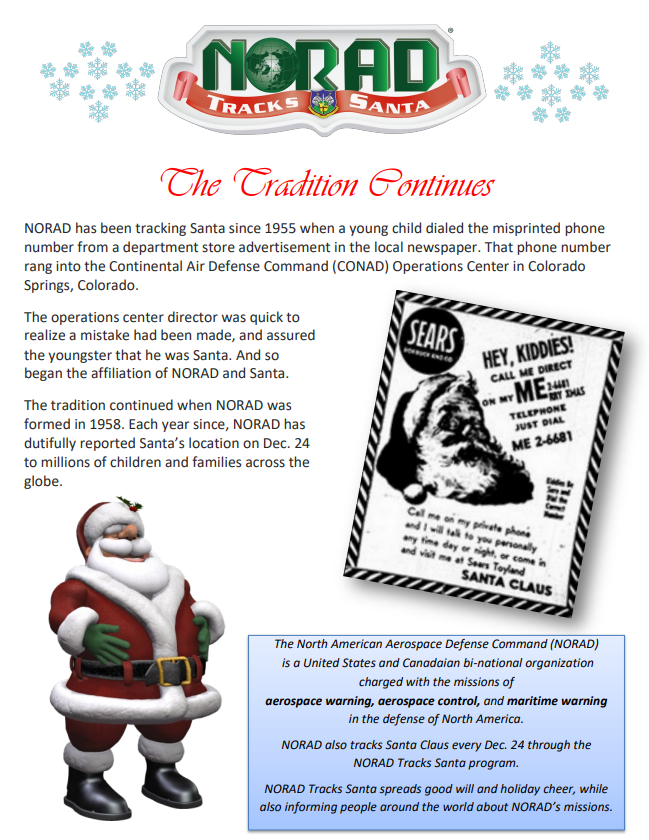
NORAD Tracking Santa Since 1955
NORAD, the North American Aerospace Defense Command, is known for its mission to track everything in the sky in order to provide threat warnings, but did you know that it also tracks Santa and his reindeer every year? For the past few years, the NORAD Santa website has been publicized across the Internet, and visitors to the website can start enjoying the digital festivities on December 1st. Once the site is live, children and adults from around the world can enjoy playing Christmas-themed games and viewing the map. The tracking of Santa starts on December 24, and viewers can watch Santa fly around the world, delivering presents to all the good little boys and girls. Of course, you might be wondering how NORAD started tracking Santa. Well, as it turns out, it was all due to a wrong number. Let’s take a look at the history of tracking Santa on his flight from the North Pole to almost every house in the world.
A Sleigh Spotted in 1948 – The First U.S. Military Announcement of Santa
Before NORAD started tracking Santa, there was an announcement by the U.S. Air Force in 1948. The warning alerted military personnel to the sighting of an unidentified sleigh on the early warning radar net. This sleigh was powered by eight reindeer and flying at an altitude of 14,000 feet on a heading of one eight zero. The Associated Press (AP), founded in 1846, heard this military report and dispersed it to the public. This was the first military acknowledgment of Santa Claus, and another announcement would not be heard for several years.
A Wrong Number in 1955
In 1955, a department store printed the phone number of the North Pole so that children could call Santa. Depending on the account, the phone number was printed wrong, or the little boy dialed the number wrong, but either way, when the child went to call Santa, he accidentally called CONAD (Continental Air Defense Command), which was located in Colorado Springs. CONAD was active from September 1, 1954, to June 30, 1975, and it was part of the United States Department of Defense.
The goal of CONAD was to provide a warning to the US military if the Soviet Union sent a bomber air attack. Today, a similar mission falls under the duties of NORAD.
However, the little boy who dialed the number expected to talk to Santa Claus, not military personnel. However, when the phone rang, it was answered by CONAD’s operations director, Harry Shoup, instead of Santa Claus. Luckily, the Shoup realized the mistake and managed to convince the young boy that he was, indeed, Santa Claus. The holiday was saved for one little boy, and Shoup became known as the Santa Colonel.
Shoup was hoping for a one-off event, but in 1956, Shoup was informed that both the Associated Press and United Press International were waiting for confirmation that Santa had been sighted. Reluctantly, Shoup agreed, and Colonel Barney Oldfield, the public affairs officer, announced that Santa and his sleigh had, once again, been sighted.
NORAD Took Over Announcing Santa in 1958
Just two years later, in 1958, NORAD took over announcing the sighting of Santa Claus, and since then, the announcements of Santa’s arrival have only become more elaborate. For example, in 1960, Santa sightings were reported by the Saint-Hubert command post in Quebec, Canada. At that time, the officers stated that an S. Claus was flying over the area and assumed to be friendly. Throughout the night, the officers continued to report Santa’s location. Some reports even announced diversions to Santa’s route and possible reindeer injuries in order to make the reports sound more believable.
The Santa Sighting Hotline in 1981
In 1981, a phone number was published in the U.S. that allowed children to call and get updates on Santa’s progress on Christmas Eve.
Santa Sightings in Modern Times
Since the 1950s, eager children could learn of Santa’s path through telephone calls, radio and television announcements, and even via the Christmas Eve weather programs. Since the late 1990s, tracking Santa has been as easy as opening a Webbrowser and searching “Santa Tracker.”
Today, the site to watch is www.noradsanta.org, and it goes live on December 1st. In addition to the website, Santa lovers can follow Santa on Facebook at @noradsanta or on X(Twitter) at @noradsanta. Adults and children can also email and call. In order to manage the volume of Santa sighting requests, it takes a team of 1,200+ volunteers, and in any given year, they answer 130,000 calls and 10,000 emails, and those calls and emails come from more than 200 countries.
The NoradSanta website starts its mission in November of each year, and it’s a team effort. Each year, about 70 people, including government employees and civilians, start the process of setting up the Santa tracking website, updating and launching the apps, and getting the phone lines ready so that on December 1st, the 1,500 volunteers are ready to take the first calls, answer the social media comments and reply to the thousands of emails that they receive each year.
If you’re excited to track Santa this year, the website goes live on December 1, 2024, and the call center opens at 6 AM EST on December 24, 2024.
